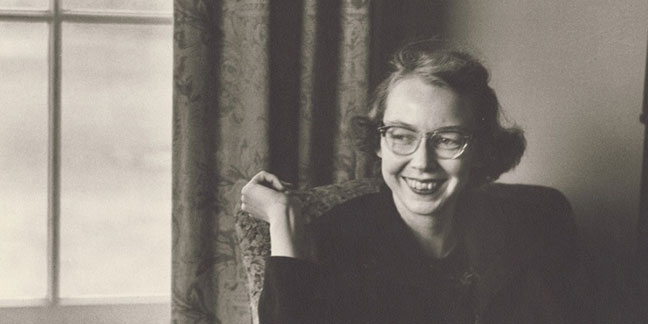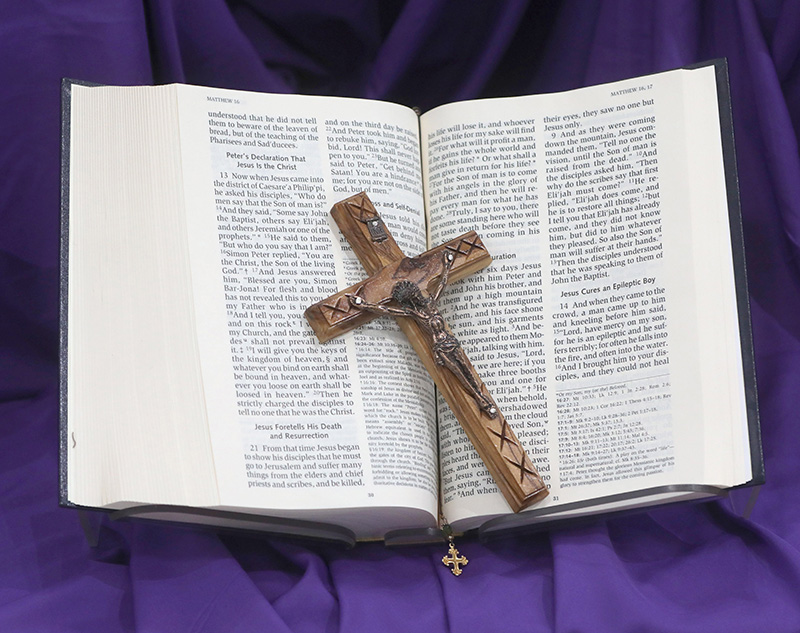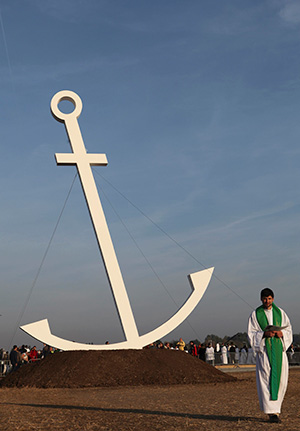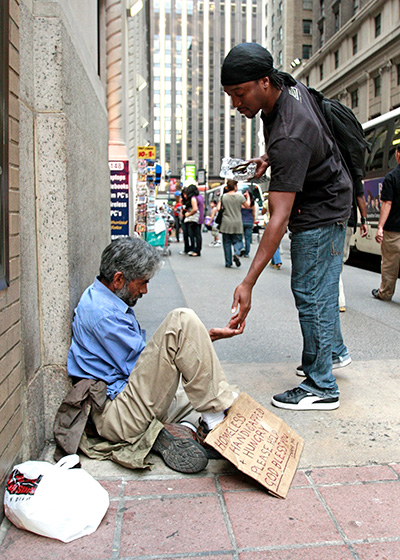March 25 marks the 98th birthday of the late Flannery O’Connor
 Flannery O’Connor is seen in this undated photo. (CNS | courtesy 11th Street Lot)Reading Flannery O’Connor requires a stout heart and a strong stomach.
Flannery O’Connor is seen in this undated photo. (CNS | courtesy 11th Street Lot)Reading Flannery O’Connor requires a stout heart and a strong stomach.
In her short life before she died of lupus, she wrote two novels and roughly two dozen short stories that continue to shock and unsettle us. With a wicked pen, she gleefully maims and kills off her characters in a million disturbing ways: They get drowned, hanged, run over by cars (twice in a row), wrapped in barbed wire and beaten to death. Her characters are prostitutes, pedophiles, arsonists, murderers, nihilists, and (worst of all for O’Connor), salesmen. But if you read her biography, she’s practically the patron saint of Catholic fiction: a devout, daily Mass Catholic who read St. Thomas Aquinas in her spare time and made a pilgrimage to the Shrine of Our Lady of Lourdes.
As readers, we wonder, “Is there something I’m missing?” How should we read O’Connor’s writing, and where is her faith in the pages of such brutal fiction?
Readers of O’Connor will notice that most of her stories follow one basic biblical narrative: St. Paul on the road to Damascus. Again and again, she depicts an event of searing violence in which divine grace shocks a hard-hearted, wicked or selfish person into a moment of recognition. In this terrible moment O’Connor offers her characters a choice, a flash of self-knowledge and an encounter with God that utterly burns away their illusions.
O’Connor does this best in one of my favorite tales, “Good Country People,” where she tells the story of Hulga, a nihilist with a Ph.D. in philosophy and a wooden leg. Convinced of the meaninglessness of life and that morality means nothing, the atheist Hulga lives consumed by pride and anger until she meets a traveling
Bible salesman who seduces her and steals her wooden leg, leaving her stranded and legless in the loft of a barn.
On his way down the ladder, the salesman sneers, “You ain’t so smart. I been believing in nothing ever since I was born!” Horrified to find a man who actually lives out the philosophy she claims to believe, Hulga now faces a pivotal choice as the story ends. And indeed the choice is ours as well: Do we accept this painful revelation of the truth, or do we return to a life of emptiness and sin? O’Connor’s tales do not always reveal what her characters decide: sometimes she leaves it to us to choose.
What O’Connor does in “Good Country People” is to reveal to Hulga (and to us) the true face of evil. O’Connor knew as she wrote her fiction that in an age of relativism we have lost a proper sense of right and wrong. Dulled by our own sins and by the de-Christianization of Western culture, we have lost the will and the ability to distinguish between good and evil. As she once wrote in an essay:
“When you can assume that your audience holds the same beliefs as you do, you can relax a little and use more normal means of talking to it; when you have to assume that it does not, then you have to make your vision apparent by shock – to the hard of hearing you shout, and for the almost-blind you draw large and startling figures.”
In a Western culture that accepts sin as personal preference and dismisses moral truth-claims as ideology or bigotry, modern man needs an arresting, visceral depiction of evil that can shock everyone into agreeing, “This is wrong.” For O’Connor, the logical extreme of godlessness is a pervert with a fetish for artificial body parts. As the Misfit, a serial killer in her story “A Good Man is Hard to Find,” says: “It’s nothing for you to do but enjoy the few minutes you got left the best way you can – by killing somebody or burning down his house or doing some other meanness to him. No pleasure but meanness….”
But we can see a deeper truth behind O’Connor’s terrific fictional violence: she wants to show us the way that Divine Providence can bring good even out of terrible evil. To many of us, the problem of evil remains perhaps the most compelling argument against the existence of a loving and all-powerful God. O’Connor answers this by showing how God incorporates the violent sins of men into His plan. In O’Connor’s novel “Wise Blood,” Hazel Motes, an atheist preacher of the “Church without Christ” runs over a rival prophet named Solace Layfield with his car. Although Layfield was only pretending to be a prophet to make money on street corners, he is forced to confront the ultimate things when he gets murdered by Motes. In his last moments, he confesses his sins and calls out the name of Jesus. Just minutes after working as a false prophet for three dollars a night, Layfield receives one of O’Connor’s famous wake-up calls and finally responds to grace. Little wonder, then, that she named him “Solace.”
In O’Connor’s fiction, God allows acts of violence to bring about spiritual healing in wounded and sinful characters because she believes that violent encounters strip away the nonessential and make us confront the Truth of things. “It is the extreme situation that best reveals what we are essentially,” O’Connor told an audience once. “The man in the violent situation reveals those qualities least dispensable to his personality, those qualities which are all he will have to take into eternity with him; and since the characters in this story are all on the verge of eternity, it is appropriate to think of what they take with them.”
There’s nothing like being about to die to help you reassess your priorities.
Finally, the events in O’Connor’s fiction should remind us that God brought about the redemption of all human beings precisely through permitting an act of unspeakable violence: the crucifixion of Jesus Christ. If God can bring cosmic victory out of the apparently senseless, spiteful torture and execution of His innocent Son, then He can, as St. Paul says in Romans 8:28, make “all things work together unto good.”
The truth is that the strange art of Flannery O’Connor will continue to puzzle and provoke us. As she once wrote, “We Catholics are very much given to the Instant Answer. Fiction doesn’t have any. It leaves us, like Job, with a renewed sense of mystery.” In her brief but fierce career as an American Catholic writer, O’Connor left us a vivid, challenging collection of works, her stark characters and plots standing out in sharp relief from the pages of her books. It’s a body of work not easy to encounter, but it’s one that is impossible to forget. So buckle up: If you read O’Connor’s stories of grace, the life you save may be your own.
Dr. Kelly Scott Franklin is a writer and associate professor of English at Hillsdale College. This article first appeared in Catholic World Report.
 Lent gets its name from a word meaning “springtime,” the time of year when the hours of daylight are lengthening and the sun is bringing back its warmth and light.
Lent gets its name from a word meaning “springtime,” the time of year when the hours of daylight are lengthening and the sun is bringing back its warmth and light.
The Lenten season is a time of hope: We deepen our relationship with Christ through our Lenten disciplines and look to His crucifixion, death and resurrection to overcome the darkness that can cause us to struggle and despair.
Some days we may not feel the love of God that is always present, but we can rely on hope to move us forward in faith, especially during this Jubilee Year, which Pope Francis has given the theme “Pilgrims of Hope.” Exercise hope this Lent and find renewal for the coming Easter season.
Hope is a theological virtue, a gift from God that helps us act as His children. Received at baptism, hope gives us confidence and inspiration as we look forward to salvation. Hope allows us to move forward in faith even in the most difficult times. Hope can help us feel secure in the midst of our own failings or the injustices we see in the world around us.
St. Thomas Aquinas said, “Hope denotes a movement or a stretching forth of the appetite toward an arduous good.” In other words, we are reaching for the goodness of God when we exercise hope – even when it isn’t easy.
Hope is also a form of trust in, and surrendering to our loving God. We have faith in His goodness, and we trust His guidance for our lives. And, while hope is a gift, it is also an active choice we make to stretch toward God’s goodness.
This stretching exercise can take many forms as we live the days of Lent.
 A pedestrian gives money to a homeless man sitting outside St. Francis of Assisi Church in New York City. Almsgiving, donating money or goods to the poor and performing other acts of charity, is one of the three pillars of Lent, along with prayer and fasting. (OSV News)Pray with hope
A pedestrian gives money to a homeless man sitting outside St. Francis of Assisi Church in New York City. Almsgiving, donating money or goods to the poor and performing other acts of charity, is one of the three pillars of Lent, along with prayer and fasting. (OSV News)Pray with hope
The season of Lent calls us to deepen our prayer lives. St. Padre Pio’s famous phrase, “Pray, hope and don’t worry,” is a reminder that prayer can give us comfort when we place our hope in God. Prayer shows our reliance on and confidence in God. Along with traditional Catholic prayers, it is helpful to pray with God’s Word. This Lent, renew your prayer life by reflecting on these hope-filled Scripture passages:
“We who have taken refuge might be strongly encouraged to hold fast to the hope that lies before us. This we have as an anchor of the soul, sure and firm” (Heb 6:18-19).
“Rejoice in hope, endure in affliction, persevere in prayer” (Rom 12:12).
“May the God of hope fill you with all joy and peace in believing, so that you may abound in hope by the power of the Holy Spirit” (Rom 15:13).
“Let us hold unwaveringly to our confession that gives us hope, for He who made the promise is trustworthy” (Heb 10:23).
Another way to deepen our faith this Lent is to learn and recite the Act of Hope. Consider God’s mercy as you reflect on Christ’s death and resurrection and find hope in the promise of salvation: “O my God, relying on Your infinite mercy and promises, I hope to obtain pardon of my sins, the help of Your grace, and life everlasting, through the merits of Jesus Christ, my Lord and Redeemer. Amen.”
Fast with hope
During Lent, Catholics are called to days of fasting from food and abstinence from meat. The goal is to deepen our relationship with Christ as we experience sacrifice in honor of his sacrifice for us. Fasting can help us feel solidarity with the poor. Many Catholics traditionally “give up” something for Lent. Here are some ideas to make your Lenten sacrifice a hope-building exercise.
Refrain from negative or comments; try saying things only in positive ways. Avoid watching television or movies with negative messages. Give away items that are burdening you with clutter; find new homes for them with a charity. Trade the time you usually spend on screens to take walks with family or friends. Skip buying desserts or treats and use the money you save to purchase flowers for someone who needs a day-brightener.
As you fast, consider Pope Francis’ April 2017 TED Talk in which he addressed misconceptions around hope: “Feeling hopeful does not mean to be optimistically naive and ignore the tragedy humanity is facing. Hope is the virtue of a heart that doesn’t lock itself into darkness, that doesn’t dwell on the past, (that) does not simply get by in the present, but is able to see a tomorrow. … And it can do so much, because a tiny flicker of light that feeds on hope is enough to shatter the shield of darkness.”
Give alms with hope
“It is in giving that we receive,” according to the Prayer of St. Francis. Almsgiving can seem the easiest of Lenten disciplines. Most of our parishes have opportunities to donate funds to missions or the poor, and these are important works of charity.
 A priest walks past a large anchor before a Mass celebrated by Pope Benedict XVI in Brno, Czech Republic, Sept. 27, 2009. (Catholic News Service)Giving funds to help support others has been a part of Lent since the earliest days of Christianity and brings hope to others. However, as St. Teresa of Kolkata said, “It’s not how much we give but how much love we put into the giving” that’s important.
A priest walks past a large anchor before a Mass celebrated by Pope Benedict XVI in Brno, Czech Republic, Sept. 27, 2009. (Catholic News Service)Giving funds to help support others has been a part of Lent since the earliest days of Christianity and brings hope to others. However, as St. Teresa of Kolkata said, “It’s not how much we give but how much love we put into the giving” that’s important.
This Lent, consider volunteering at your parish during one of its Lenten activities, or help clean or decorate the church in preparation for Holy Week. Write cards to family and friends expressing ways they help you feel more hopeful. At Mass, introduce yourself to one new person each week of Lent and show them God’s love by sitting with them during the liturgy. Actively watch for someone each day who needs an extra helping hand.
You could also keep a Lenten Hope List. Write down names of those you encounter who need an extra dose of love and support. Pray for them and check in with them during Lent to show your care.
St. Bonaventure summed things up nicely: “Three things are necessary to everyone: truth that brings understanding, love of Christ which brings compassion, and endurance of hope which brings perseverance.” While Lent is traditionally the season to renew and refocus our discipleship through deeper experiences of prayer, fasting and almsgiving, it is important to remember that Christians are also called to live in hope.
— OSV News
The anchor, a symbol of hope amid storms
Did you know that the anchor represents hope? During the time of Roman persecution of Christians, it was adopted as a Christian symbol because it forms a cross. It was found in the catacombs and in homes, serving as an encouragement to Christians without drawing the attention of authorities. Since that time, the anchor cross is found in many churches and reminds us of hope and stability in Christ. As you meditate on the cross this Lent, consider the anchor cross and use it as an inspiration for hope in stormy times.


